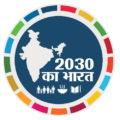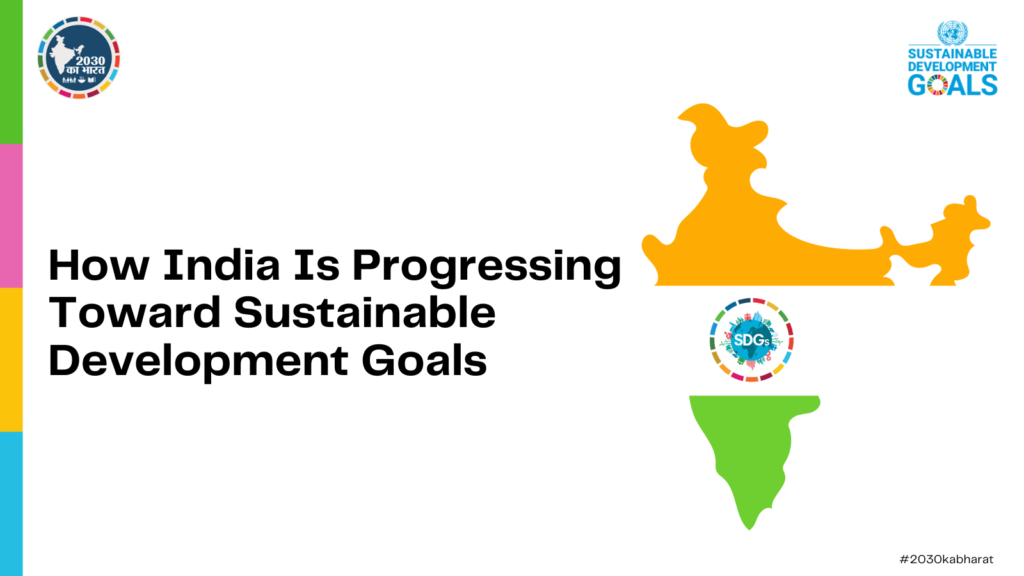The progress of the world in meeting the Sustainable Development Goals (SDGs) largely depends on India’s journey. Being the second most populous country in the world and one of the fastest-growing economies, India plays a pivotal role in determining the success of the SDGs globally. India not only contributed significantly to the formulation of the SDG Goals but also ensured that much of its National Development Agenda aligns with these global goals.
At the 2015 Sustainable Development Summit in New York, the Prime Minister of India reaffirmed India’s strong commitment to Agenda 2030 and emphasized that the country’s development priorities mirror the Sustainable Development Goals. Since then, both national and state-level efforts have been focused on tackling key issues like No Poverty, hunger, health, Quality Education, and gender equality, ensuring sustainable growth.
India’s Progress So Far.
It is widely accepted that India’s success in achieving the SDGs will greatly influence the global outcome. India has already made significant progress in several areas. The Indian Parliament has taken numerous initiatives to propel the SDG agenda forward, with key policies and programmes aimed at fostering inclusive and sustainable development.
Key Entities Driving SDG Implementation in India
NITI Aayog:
NITI Aayog has been entrusted with the responsibility of coordinating the country’s progress toward the SDG Goals. It adopts a collaborative approach, engaging with central ministries, state governments, union territories (UTs), civil society organizations, academia, and the private sector. To ensure alignment of national schemes with SDG targets, NITI Aayog has developed a comprehensive mapping framework.
In addition, NITI Aayog has conducted 22 national and regional consultations so far to review and strengthen SDG implementation across the country.
Ministry of Statistics and Programme Implementation (MoSPI):
MoSPI has played a critical role by drafting the National Indicator Framework (NIF) in collaboration with various ministries and state governments. It also represents India in global discussions on the SDG indicator framework.
State and UT Governments:
Several state and UT governments have mapped their development schemes against the Sustainable Development Goals. They have undertaken visioning exercises, medium-term strategy development, and short-term action planning to accelerate progress toward achieving the goals. States like Kerala, Himachal Pradesh, and UTs like Chandigarh have emerged as leaders in SDG performance due to their focused efforts on health, education, clean water, and sanitation.
Success Stories: States Leading the Way
Kerala’s top rank in SDG implementation can be attributed to its superior performance in health, hunger eradication, gender equality, and Quality Education. Himachal Pradesh has excelled in providing clean water and sanitation, reducing inequalities, and preserving its natural ecosystems. Among the UTs, Chandigarh stands out for its exemplary efforts in ensuring clean water and sanitation.
Over the past two decades, India has achieved remarkable progress in economic growth and poverty reduction. According to Tendulkar Committee estimates, the poverty rate declined by 18% between 1993-94 and 2004-05 and further decreased by 41% between 2004-05 and 2011-12. Improved economic performance, coupled with targeted government interventions, has significantly reduced poverty across various socio-economic groups.
Key Government Initiatives Supporting SDGs
India has launched several national and state-level initiatives aimed at achieving the Sustainable Development Goals:
- MGNREGA (Mahatma Gandhi National Rural Employment Guarantee Act):
Provides rural households with guaranteed employment, contributing to poverty alleviation and sustainable livelihoods. - PMJDY (Pradhan Mantri Jan Dhan Yojana):
Ensures financial inclusion by providing every household with access to banking services. - National Food Security Act (NFSA), 2013:
Mandates the provision of subsidized food grains to 75% of the rural population and 50% of the urban population through the Public Distribution System. - Poshan Abhiyaan:
Launched to tackle malnutrition, stunting, and anemia among children, pregnant women, and lactating mothers. - Sarva Shiksha Abhiyan:
A flagship programme aimed at universalizing elementary education and improving the quality of school education. - Mid-Day Meal Scheme:
Provides free meals to schoolchildren, enhancing nutritional levels and encouraging school attendance.
The Role of 2030kabharat in Achieving SDGs
While the government is making strides in SDG implementation, organizations like 2030kabharat are playing a crucial role in bridging gaps and amplifying efforts at the grassroots level. 2030kaBharat focuses on three primary SDG Goals:
- SDG 1 (No Poverty):
Through livelihood programs and skill development initiatives, the organization aims to empower marginalized communities and create sustainable sources of income. - SDG 2 (Zero Hunger):
Collaborating with local partners and corporates, 2030kabharat ensures the distribution of nutritious food to underserved populations. It also promotes sustainable agricultural practices to enhance food security. - SDG 4 (Quality Education):
The Teachers’ Empowerment Program (TEP) is a key initiative by 2030काभारत to train educators and improve the quality of education in rural areas. Additionally, digital learning tools and infrastructure development are prioritized to ensure equitable access to education.
By working closely with local governments, corporates, and communities, 2030kabharat aims to create measurable and lasting impacts in the areas of poverty eradication, hunger reduction, and education.
Challenges and the Way Forward
Despite significant progress, several challenges remain in India’s path toward achieving the Sustainable Development Goals:
- Resource Allocation:
Ensuring adequate financial and human resources for SDG-related programmes across diverse regions. - Data Availability:
Reliable and timely data collection at the local level is essential for monitoring progress and making informed decisions. - Social Inequality:
Bridging the gap between urban and rural areas in terms of access to healthcare, education, and economic opportunities remains a major hurdle.
The Need for Multi-Stakeholder Collaboration
Achieving the SDG Goals requires collective action from all sectors of society—government, private sector, civil society, and individuals. Public-private partnerships (PPPs) can play a transformative role in mobilizing resources, fostering innovation, and scaling impactful solutions. The CSR initiatives of various corporates have already shown promising results in areas like education, healthcare, and livelihood generation.
Technology will also be a key enabler in accelerating progress. Initiatives like Digital India, which promote e-governance and digital literacy, can be leveraged to enhance the reach and effectiveness of SDG programmes.
Conclusion
India’s journey toward achieving the Sustainable Development Goals is both ambitious and essential for global success. With committed efforts from the government, active participation from organizations like 2030kabharat , and support from citizens, a sustainable and inclusive future is within reach. However, continuous learning, innovation, and collaboration will be critical to overcoming existing challenges and ensuring long-term success.
As we move closer to 2030, every step taken today will define the future of not just India but the entire world. Let’s join hands and work together toward a better, sustainable tomorrow.
“Your small action today can contribute to a big change tomorrow. Be a part of the 2030kabharat mission and help us shape a sustainable future.”

